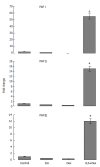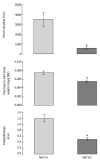Dexamethasone mediates protection against acute pancreatitis via upregulation of pancreatitis-associated proteins
- PMID: 17106929
- PMCID: PMC2700294
- DOI: 10.3748/wjg.v12.i42.6806
Dexamethasone mediates protection against acute pancreatitis via upregulation of pancreatitis-associated proteins
Abstract
Aim: To examine the influence of dexamethasone on pancreatitis-associated protein (PAP) gene expression using both in vitro and in vivo models of acute pancreatitis and to study how PAP gene expression correlates with severity of pancreatitis.
Methods: In vitro, IL-6 stimulated pancreas acinar AR42J cells were cultured with increasing concentrations of dexamethasone and assayed for PAP expression (RT-PCR). In vivo, pancreatitis was induced in rats by retrograde injection of 40 g/L taurocholate into the pancreatic duct. Animals were pretreated with dexamethasone (2 mg/kg) daily or saline for 4 d. Pancreata and serum were harvested after 24 h and gene expression levels of PAP I, II and III were measured by RT-PCR. Severity of pancreatitis was based on serum amylase, pancreatic wet weight, and histopathological score.
Results: In vitro, dexamethasone and IL-6 induced a marked transcription of PAP I, II and III genes in AR42J cells at 24 h (P < 0.05 for all comparisons). In vivo, pancreas mRNA levels of PAP I, II or III increased by 2.6-fold, 1.9-fold, and 1.3-fold respectively after dexamethasone treatment, compared with saline treated animals. Serum amylase levels and edema were significantly lower in the dexamethasone group compared with the saline group. Histopathologic evaluation revealed less inflammation and necrosis in pancreata obtained from dexamethasone treated animals (P < 0.05).
Conclusion: Dexamethasone significantly decreases the severity of pancreatitis. The protective mechanism of dexamethasone may be via upregulating PAP gene expression during injury.
Figures




Similar articles
-
Targeted inhibition of gene expression of pancreatitis-associated proteins exacerbates the severity of acute pancreatitis in rats.Scand J Gastroenterol. 2004 Sep;39(9):870-81. doi: 10.1080/00365520410006477. Scand J Gastroenterol. 2004. PMID: 15513386 Free PMC article.
-
Localization of rat pancreatitis-associated protein during bile salt-induced pancreatitis.Gastroenterology. 1997 Feb;112(2):543-50. doi: 10.1053/gast.1997.v112.pm9024308. Gastroenterology. 1997. PMID: 9024308
-
Small-interference RNA gene knockdown of pancreatitis-associated proteins in rat acute pancreatitis.Pancreas. 2008 May;36(4):402-10. doi: 10.1097/MPA.0b013e31815f3933. Pancreas. 2008. PMID: 18437087 Free PMC article.
-
Pancreatitis-associated protein: from a lectin to an anti-inflammatory cytokine.World J Gastroenterol. 2007 Jan 14;13(2):170-4. doi: 10.3748/wjg.v13.i2.170. World J Gastroenterol. 2007. PMID: 17226896 Free PMC article. Review.
-
The acute phase reaction of the exocrine pancreas. Gene expression and synthesis of pancreatitis-associated proteins.Digestion. 1994;55(2):65-72. doi: 10.1159/000201127. Digestion. 1994. PMID: 8187976 Review.
Cited by
-
Comparison of His and GST tagged versions of recombinant pancreatitis associated protein 2 in modulation of inflammatory responses.Inflamm Res. 2010 Oct;59(10):827-35. doi: 10.1007/s00011-010-0194-4. Epub 2010 Apr 16. Inflamm Res. 2010. PMID: 20396928
-
Pancreatic regenerating protein I in chronic pancreatitis and aging: implications for new therapeutic approaches to diabetes.Pancreas. 2008 Nov;37(4):386-95. doi: 10.1097/MPA.0b013e31817f7893. Pancreas. 2008. PMID: 18953250 Free PMC article.
-
Pitfalls in AR42J-model of cerulein-induced acute pancreatitis.PLoS One. 2021 Jan 25;16(1):e0242706. doi: 10.1371/journal.pone.0242706. eCollection 2021. PLoS One. 2021. PMID: 33493150 Free PMC article.
-
Clinical observation on the effect of dexamethasone and Chinese herbal decoction for purgation in severe acute pancreatitis patients.Chin J Integr Med. 2011 Feb;17(2):141-5. doi: 10.1007/s11655-011-0630-5. Epub 2011 Mar 9. Chin J Integr Med. 2011. PMID: 21390581 Clinical Trial.
-
Association between Severe SARS-CoV-2 Infection and Severe Acute Pancreatitis in Pregnancy and Postpartum.J Clin Med. 2022 May 2;11(9):2554. doi: 10.3390/jcm11092554. J Clin Med. 2022. PMID: 35566679 Free PMC article.
References
-
- Iovanna JL, Keim V, Michel R, Dagorn JC. Pancreatic gene expression is altered during acute experimental pancreatitis in the rat. Am J Physiol. 1991;261:G485–G489. - PubMed
-
- Iovanna JL, Lechene de la Porte P, Dagorn JC. Expression of genes associated with dedifferentiation and cell proliferation during pancreatic regeneration following acute pancreatitis. Pancreas. 1992;7:712–718. - PubMed
-
- Keim V, Iovanna JL, Rohr G, Usadel KH, Dagorn JC. Characterization of a rat pancreatic secretory protein associated with pancreatitis. Gastroenterology. 1991;100:775–782. - PubMed
-
- Stephanova E, Tissir F, Dusetti N, Iovanna J, Szpirer J, Szpirer C. The rat genes encoding the pancreatitis-associated proteins I, II and III (Pap1, Pap2, Pap3), and the lithostathin/pancreatic stone protein/regeneration protein (Reg) colocalize at 4q33-->q34. Cytogenet Cell Genet. 1996;72:83–85. - PubMed
Publication types
MeSH terms
Substances
Grants and funding
LinkOut - more resources
Full Text Sources
Other Literature Sources
Medical
Research Materials

